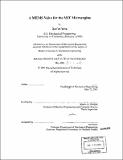A MEMS valve for the MIT Microengine
Author(s)
Yang, Xue'en, 1975-
DownloadFull printable version (9.842Mb)
Alternative title
Microelectromechanical systems valve for the Massachusetts Institute of Technology Microengine
Other Contributors
Massachusetts Institute of Technology. Dept. of Mechanical Engineering.
Advisor
Martin A. Schmidt.
Terms of use
Metadata
Show full item recordAbstract
A microfabricated, electro-statically actuated, on/off gas valve made of silicon material has been designed, fabricated and tested. The valve will be a fuel control component in a micro-scale gas turbine engine. Room-temperature testing results using nitrogen have demonstrated repeatable valve functions and choked flow characteristics. MIT has initiated a project to build a micro-scale gas turbine generator for high power density output in applications such as portable power source or micro air vehicles. For closed-loop operation, a valve is required to be able to withstand 10 atm upstream pressure under high-temperature operating environment (700K), and result in a maximum flow rate of 600 sccm while has very low gas leakage rate. These system requirements can not be met by previously reported MEMS valve, many of which are designed for low temperature or low pressure applications. The microengine prototype valve comprises of three fusion-bonded SOI wafers. Electrostatic- actuation is used to lift the silicon boss actuator supported on four L-shaped tethers and open against high pressure. Polysilicon is chosen as the seat material for high-temperature operating environment. The flow path of the valve is designed to be choked and because of the micro-scale nature, both viscous and compressible effects are taken into consideration in flow analysis with axis-symmetric geometric. It is demonstrated that at operating pressure of 10 atmosphere, the valve can be opened at less than 150 V with power consumption that is less than 0.04 mW. The gas leakage at the same pressure is estimated to be less than 0.03 sccm Helium, while the open flow rate is 43 sccm (3 g/hr) nitrogen. Commercial fluid analysis package CFD FLUET is used to model the flow and very good agreement with experimental data is obtained. In the future, an array of 20 on/off valves (to obtain 5% accuracy in flow rate) will be used to accomplish the fuel control scheme of the microengine.
Description
Thesis (S.M.)--Massachusetts Institute of Technology, Dept. of Mechanical Engineering, 2001. Includes bibliographical references (p. 95-96).
Date issued
2001Department
Massachusetts Institute of Technology. Department of Mechanical EngineeringPublisher
Massachusetts Institute of Technology
Keywords
Mechanical Engineering.